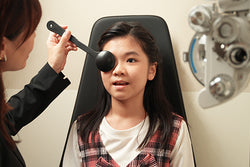
Visual Acuity and Field of Vision: Cornerstones of Safe Driving
When it comes to safe driving, two crucial factors stand out: visual acuity and visual field. Visual acuity measures our ability to see fine details1, such as road signs and distant objects, ensuring we can recognise obstacles and pedestrians well in advance. On the other hand, visual field consists of how wide our field of vision is when focused on a single point, allowing us to perceive neighboring vehicles and objects in our peripheral vision2.
Navigating the Spectrum of Lighting Conditions
Driving exposes us to a spectrum of lighting conditions. While a bright, sunny day can be a visual delight, it can also present challenges in the form of blinding glare that compromise our vision and safety3. Driving poses various vision-related risks4, including:
- Blurry vision due to uncorrected refractive errors
- Glare from headlights
- Visual field deficits resulting from eye diseases like glaucoma
- Poor night vision or night blindness
The Impact of Uncorrected Refractive Errors
Uncorrected refractive errors, such as myopia (nearsightedness) and astigmatism, can significantly affect our vision, especially while driving. Myopia may lead to the failure to recognise warning signals or pedestrians at slightly greater distances. Conversely, uncorrected astigmatism can result in blurred vision at all distances and increase susceptibility to glare, particularly during night driving5. This condition scatters light, causing halos or streaks around light sources, especially in low-light conditions6.
Confronting the Glare Challenge
Glare, whether from bright or dim lights, is a common adversary on the road. Attempting to discern objects under excessively bright lights can cause squinting and watery eyes, while dim lighting, prevalent during nighttime driving, diminishes image contrast, further impairing our vision7.
One effective way to combat glare and enhance night driving safety is by wearing specialised driving glasses. Equipped with an anti-reflective coating, these glasses reduce light reflections8 from sources like headlights and streetlamps. By mitigating glare, they prevent temporary blindness, enhancing both your safety and that of other road users.
Tips for Improved Night Driving Visibility
To enhance your visibility while driving at night, consider these practical tips:
- Ensure your prescription for corrective glasses or contact lenses is up-to-date. Explore specialised lenses that reduce reflections and glare.
- Keep your windshield, windows, headlights, and taillights clean and well-maintained for optimal visibility.
- Regularly adjust your mirrors to minimise blind spots.
By understanding the underlying factors contributing to poor night vision and implementing these strategies, you can enjoy safer and more comfortable night drives, both for yourself and other road users.
How Crizal® Drive Helps with Night Driving and Safety
Experience the difference with Crizal® Drive lenses, designed to enhance your safety and clarity during night driving. Regardless of whether you drive occasionally or regularly, the distracting halos that accompany night drives can affect your vision.
With up to 90% less reflection compared to ordinary lenses, Crizal® Drive minimises hazardous glare from surrounding lights, allowing you to drive confidently and securely in low light conditions9. These lenses are not limited to just the night; they also maintain sharp vision during the day, ensuring a comfortable and clear driving experience around the clock.
For more information on Crizal® Drive, click here or approach our staff at your nearest Spectacle Hut store.
1. Levenson JH, Kozarsky A. Visual Acuity. In: Walker HK, Hall WD, Hurst JW, editors. Clinical Methods: The History, Physical, and Laboratory Examinations. 3rd edition. Boston: Butterworths; 1990. Chapter 115. Available from: https://www.ncbi.nlm.nih.gov/books/NBK219/
2. Spector RH. Visual Fields. In: Walker HK, Hall WD, Hurst JW, editors. Clinical Methods: The History, Physical, and Laboratory Examinations. 3rd edition. Boston: Butterworths; 1990. Chapter 116. Available from: https://www.ncbi.nlm.nih.gov/books/NBK220/
3. ”The Most Dangerous Time to Drive” National Safety Council. https://www.nsc.org/road/safety-topics/driving-at-night
4. “How Do Vision & Vision Loss Impact Driving?” NVISION Eye Centers. https://www.nvisioncenters.com/education/driving-and-vision
5. “Reasons you can’t see while you drive at night” Essilor UK. https://www.essilor.com/uk-en/blog/your-life-and-your-eyes/cannot-see-when-driving-at-night/
6. “How people with astigmatism see light” All About Vision. https://www.allaboutvision.com/conditions/astigmatism-lights/
7. “Avoid Glare While Driving at Night with Night Driving Lenses.” Essilor USA. www.essilorusa.com/newsroom/avoid-glare-while-driving-at-night
8. Whelan, C. (2020, January 29). Night Driving Glasses: Do They Work? Healthline; Healthline Media. https://www.healthline.com/health/night-driving-glasses
9. “Crizal Drive Lenses” Essilor Singapore. https://www.essilor.com.sg/products/crizal-drive
← Older Post Newer Post →




